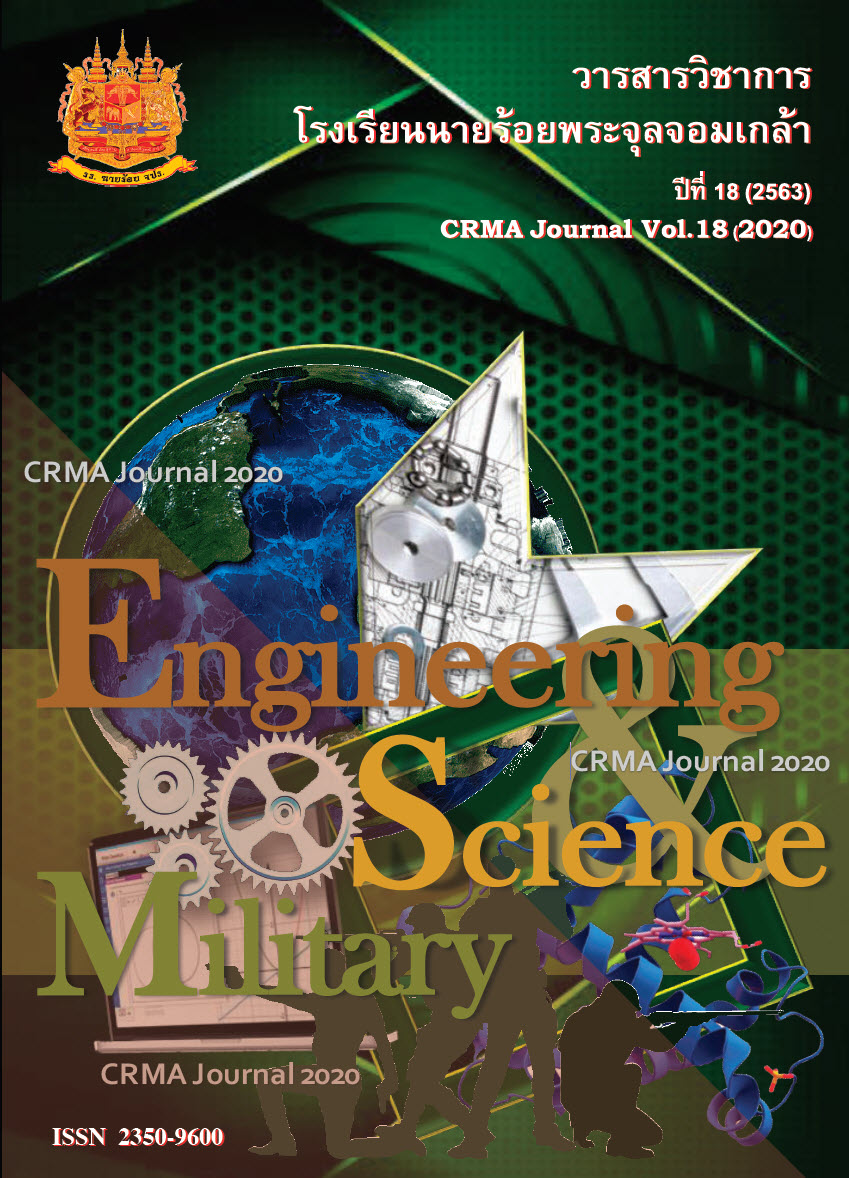แบบจำลองทางคณิตศาสตร์สำหรับการถ่ายเทความร้อนภายในกำแพงหลายชั้น
Main Article Content
บทคัดย่อ
งานวิจัยนี้เป็นการศึกษาปรากฏการณ์การถ่ายเทความร้อนภายในกำแพงหลายชั้น โดยการสร้างแบบจำลองทางคณิตศาสตร์ซึ่งใช้สมการความร้อนหนึ่งมิติที่อยู่ในรูปไร้มิติเพื่ออธิบายการถ่ายเทความร้อนจากผนังกำแพงด้านนอกที่ได้รับความร้อนจากดวงอาทิตย์ไปสู่ผนังด้านในของกำแพง โดยผ่านแต่ละชั้นของกำแพงที่สร้างจากวัสดุต่างชนิดกัน ได้แก่ ปูนซีเมนต์ที่ใช้เป็นชั้นกั้นคอนกรีตมวลเบาและคอนกรีตมอญ ประกอบกับการใช้ระเบียบวิธีผลต่างจำกัดที่ใช้แก้สมการควบคุมของแบบจำลองทางคณิตศาสตร์ โดยพิจารณากรณีกำแพง 2 ชั้น 4 ชั้น และ 5 ชั้น ตามลำดับ ผลลัพธ์ที่ได้จากการคำนวณค่าอุณหภูมิของกำแพง 2 ชั้น ในกรณีที่นำวัสดุที่ใช้ในการสร้างกำแพงด้วยอิฐมอญเป็นชั้นด้านในและอิฐมวลเบาเป็นชั้นนอก กับกรณีนำวัสดุสร้างกำแพงด้วยอิฐมอญที่เป็นชั้นด้านนอกและอิฐมวลเบาเป็นชั้นด้านใน พบว่าค่าอุณหภูมิขอบด้านในกำแพงที่ถูกคำนวณจากแบบจำลองทางคณิตศาสตร์มีค่าเท่ากัน สำหรับการถ่ายเทความร้อนกำแพง 4 ชั้น และ 5 ชั้น ซึ่งนำเสนอในรูปแบบของกราฟเส้นเปรียบเทียบค่าอุณหภูมิและตารางค่าอุณหภูมิที่ขอบด้านในของกำแพงที่เวลา 5 นาที 15 นาที 30 นาที 45 นาที 1 ชั่วโมง 1.5 ชั่วโมง 2 ชั่วโมง 2.5 ชั่วโมง และ 3 ชั่วโมง ตามลำดับ อีกทั้งผลลัพธ์ที่ได้จากแบบจำลองทางคณิตศาสตร์ที่ใช้ในงานวิจัยนี้สามารถยืนยันประสิทธิภาพการนำความร้อนของวัสดุโดยปูนซีเมนต์ที่มีการนำความร้อนสูงสุดและอิฐมวลเบามีการนำความร้อนต่ำสุด
Article Details
ผลงานที่ได้รับการตีพิมพ์ ถือเป็นลิขสิทธิ์ของวารสารฯ
References
J. Rattanachotinun, P. Pairojn, 2016. The Comparative Effectiveness of Practice of Autoclaved Aerated Concrete with Hollow Hole and Typical Autoclaved Aerated Concrete. EAU Heritage Journal Science and Technology, Vol. 10, No. 3.
J. Rattanachotinun, P. Pairojn, 2014. A Feasibility Study of Glass Solar Chimney Wall for Tropical Area, Case Study: Bangkok, Thailand. International Energy Journal, Vol. 14, No. 1, p. 95-106.
J. Rattanachotinun, P. Pairojn, 2017. Assessment of the effectiveness and practical feasibility of glass solar chimney walls by open frame in Thailand. Journal of Building Services Engineering Research & Technology, Vol. 38, No. 2, p. 151-162.
โยธิน อึ่งกุล, พิชัย นามประกาย, นริศ ประทินทอง และรังสิต ศรจิตติ, 2006. แบบจำลองทางคณิตศาสตร์การถ่ายเทความร้อนและความชื้นในบ้านที่ใช้ผนังคอนกรีตมวลเบาภายใต้สภาวะอากาศของประเทศไทย. KKU Engineering Journal, ฉบับที่ 33, น. 375-390.
วิศรุต คล้ายแจ้ง และนพรัตน์ โพธิ์ชัย, 2562. การจำลองแบบเชิงคณิตศาสตร์ของการถ่ายเทความร้อนจากผนังภายนอกสู่ผนังภายในอาคาร โดยใช้วัสดุคอนกรีตมวลเบา คอนกรีตมอญและคอนกรีตบล็อก. วารสารวิทยาศาสตร์และเทคโนโลยีนายเรืออากาศ, ฉบับที่ 15, น. 9-18.
A. Missoum, M. Elmir, M. Bouanini, B. Draoui, 2016. Numerical Simulation of Heat Transfer Through the Building Facades of Buildings Located in the City of Bechar. The International Journal of Multiphysics, Vol. 10, No. 4, p. 441-450.
สุธน รุ่งเรือง ณิชาภา มินาบูลย์ และรัฐศักดิ์ พรหมมาศ, 2018. การศึกษาคุณสมบัติของผนังเบาจากถุงกระดาษปูนซีเมนต์. วารสารวิชาการโรงเรียนนายร้อยพระจุลจอมเกล้า, ฉบับที่ 16, น.95 – 105.
M. J. Hancock, 2006. The 1 D Heat Equation. United States of America.
A. R. Mitchell, 1969. Computational Methods in Partial Differential Equations. United Kingdom : John-Wiley and Sons.

